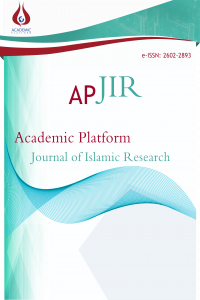Jerusalem in Emile Habibi’s Novel Sextet of the Days
This research seeks to shed light on the image of Jerusalem and its people in Emile Habibi’s novel Sextet of the
Six Days. It also presents the impact of 1948 and 1967 on the Palestinian exodus known as Nakba and Naksa, on
Jerusalem’s population, its quarters and stones. The novelist narrates the shapeless return of a nation united
under Occupation tanks and spears. The novel handles the humanitarian and social rupture of the Palestinians in
general and the people of Jerusalem in the wake of defeat. It, furthermore, depicts the gathering of the
Palestinian Diaspora in Palestine after the June War. The researcher aims to explain how the population of
Jerusalem, Muslims, and Christians resisted the Occupation. It was their love, harmony and brotherhood that
united them, along with the collaboration of Palestinians under the umbrella of both the Cross and Crescent. In
the novel, the researcher has presented the close relationship between Jerusalem, the place, and the population
who deceived strange policemen when they went through Alsadiya Quarter to Alzahira Gate until they entered
the graveyard and covered the tombs with flowers. The researcher saw that Emile Habibi has chosen a number of
characters that represented the Palestinian sects, classes and successive Palestinian generations, some of whom
lived in the British occupation era, another in the Nakba era (the 1948 war) and the other lived in both eras, the
Nakba and Naksa. Thus, through these characters, Emile Habibi is trying to present his vision of how the deal
with the Occupation. Besides, the researchers found that the women of Jerusalem are strongly present in the
novel. They can be viewed as courageous, patient and tough. They also have a great influence on rallying and
preparing fighters. Women can do many things for the sake of their homeland: they wash the prisoners’ clothes,
they serve their husband, and they also hard stones at the enemies. The novel Sextet of the Six Days is
remarkably teeming with the places of Jerusalem.
Anahtar Kelimeler:
: Jerusalem In Emile Habibi’s Noval, Sextet Of The Days, Nakba and Naksa
Jerusalem in Emile Habibi’s Novel Sextet of the Days
This research seeks to shed light on the image of Jerusalem and its people in Emile Habibi’s novel Sextet of the
Six Days. It also presents the impact of 1948 and 1967 on the Palestinian exodus known as Nakba and Naksa, on
Jerusalem’s population, its quarters and stones. The novelist narrates the shapeless return of a nation united
under Occupation tanks and spears. The novel handles the humanitarian and social rupture of the Palestinians in
general and the people of Jerusalem in the wake of defeat. It, furthermore, depicts the gathering of the
Palestinian Diaspora in Palestine after the June War. The researcher aims to explain how the population of
Jerusalem, Muslims, and Christians resisted the Occupation. It was their love, harmony and brotherhood that
united them, along with the collaboration of Palestinians under the umbrella of both the Cross and Crescent. In
the novel, the researcher has presented the close relationship between Jerusalem, the place, and the population
who deceived strange policemen when they went through Alsadiya Quarter to Alzahira Gate until they entered
the graveyard and covered the tombs with flowers. The researcher saw that Emile Habibi has chosen a number of
characters that represented the Palestinian sects, classes and successive Palestinian generations, some of whom
lived in the British occupation era, another in the Nakba era (the 1948 war) and the other lived in both eras, the
Nakba and Naksa. Thus, through these characters, Emile Habibi is trying to present his vision of how the deal
with the Occupation. Besides, the researchers found that the women of Jerusalem are strongly present in the
novel. They can be viewed as courageous, patient and tough. They also have a great influence on rallying and
preparing fighters. Women can do many things for the sake of their homeland: they wash the prisoners’ clothes,
they serve their husband, and they also hard stones at the enemies. The novel Sextet of the Six Days is
remarkably teeming with the places of Jerusalem.
___
- - حبيبي، إميل، سداسية األيام الستة، الوقاائي الصريبااااة فااااي اختفاااااء سااااعيد أبااااي الاااانحس المت ائل، وقة أخرى"، من مة التحرير الفلسيينية - دائرة اإلع م والثقافة، بياروت، آ 1980.
- - الخباص عبد ، القدس في األد العرباي الحاااااااادي فااااااااي فلسااااااااايين واألردن، دار النفائس،1990.
- Yayın Aralığı: Yılda 3 Sayı
- Başlangıç: 2017
- Yayıncı: Akademik Perspektif Derneği
Sayıdaki Diğer Makaleler
Semiology of El Quds in the Contemporary Arabic Poetry
The approaches of "Jerusalem's poem" in Samih Al–Qasim's poetry: "Al–Quds Book" as a model
Türk Ve Arap Şiirlerinde Kudüs’e Dâir Ağıt, Umut Ve Direniş
Nuri Pakdil’in Şiir Coğrafyasında Kudüs
Jerusalem and Artistic Orientations are a Formative Point of View
A Lost Legendary Humane Common Properties Called Peace and Coexistence of Homo Muslimus in Jerusalem
